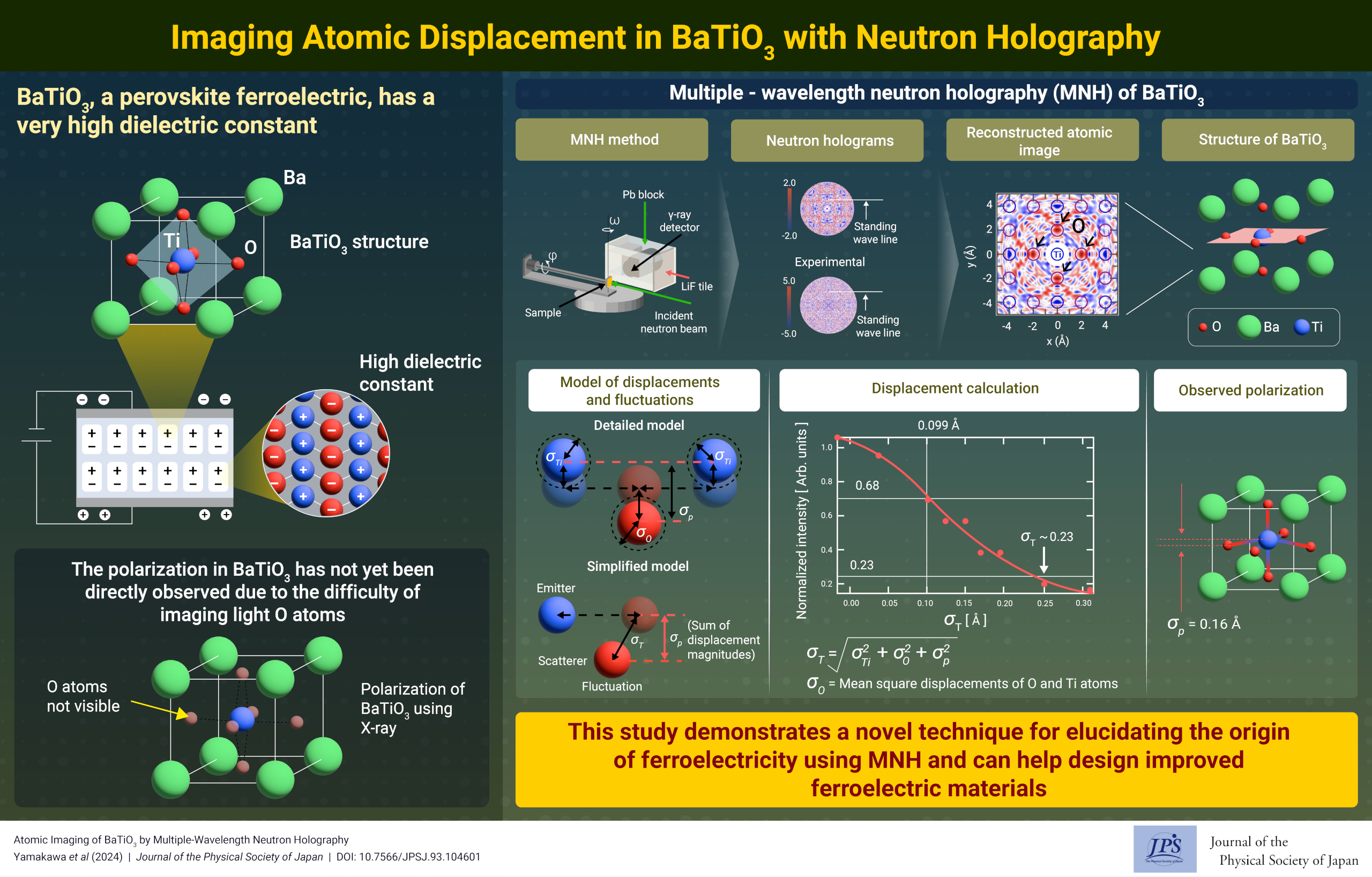Imaging Atomic Displacement in BaTiO3 with Neutron Holography
© The Physical Society of Japan
This article is on
Atomic Imaging of BaTiO3 by Multiple-Wavelength Neutron Holography
(JPSJ Editors' Choice)
J. Phys. Soc. Jpn.
93,
104601
(2024)
.
Newly developed neutron holography was applied to ferroelectric BaTiO3 to evaluate oxygen displacement, providing important structural information for improving the ability of dielectric materials to store electricity.

Dielectric materials are used in various electronic devices, such as capacitors and actuators. At the atomic scale, the positively and negatively charged ions in these devices are displaced from their original positions. Therefore, observing these displacements is essential for improving the performance of electronic devices and developing new dielectric materials.
BaTiO3 has a high capacity for electricity storage. Below 400 K, this material becomes ferroelectric owing to the displacement of the positively charged titanium and negatively charged oxygen. However, it is difficult to evaluate the displacements of the constituent ions, especially that of oxygen.
Holography is a technique for generating three-dimensional (3D) images from the interference patterns of waves. Holography with visible light is extensively used in applications such as the anticounterfeiting of banknotes. If we use quantum beams (e.g., electron beams, X-rays, and neutron beams) instead of visible light, a 3D atomic arrangement of materials can be obtained. Atomic-resolution holography with X-rays has been used to evaluate ionic displacement. However, the oxygen atoms cannot be detected because X-rays are not sensitive to light elements. Therefore, the understanding of the ionic displacement mechanism remains elusive.
In this study, we addressed this problem using a newly developed neutron holography. Unlike X-rays, neutrons are sensitive to oxygen atoms; therefore, in principle, it is possible to obtain atomic images of oxygen. The experiment was performed at the Japan Proton Accelerator Research Complex (J-PARC), which provides the world’s highest-intensity neutrons. After accurate data acquisition and processing, the researchers successfully reconstructed an atomic-scale image of BaTiO3 and obtained oxygen atomic images, as expected.
Furthermore, a detailed analysis of the image intensities obtained by the neutron holography showed that the magnitude of the oxygen displacement in BaTiO3 relative to the titanium atom was evaluated to be 0.16 Å. This value is very close to those reported in previous study [1], demonstrating the usefulness of the new analytical method.
Although these experiments were performed on standard ferroelectrics, doped materials are interesting targets. This is because dielectric performance is often enhanced by elemental doping, and neutron holography can be used to visualize the 3D atomic arrangement around doped elements. Therefore, this technique has great potential for revealing the dopant-induced displacements of cations and anions, which cannot be determined by other methods.
[1] J. Harada, T. Pedersen, and Z. Barnea, Acta Cryst. A26, 336 (1970).
(Written by K. Kimura on behalf of all authors)
Atomic Imaging of BaTiO3 by Multiple-Wavelength Neutron Holography
(JPSJ Editors' Choice)
J. Phys. Soc. Jpn.
93,
104601
(2024)
.
Share this topic
Fields
Related Articles
-
Qualitative Changes in Kinetic Pathways Driven by Hydrodynamic Interactions in Dense Colloidal Suspensions
Cross-disciplinary physics and related areas of science and technology
Statistical physics and thermodynamics
Structure and mechanical and thermal properties in condensed matter
2025-4-18
Even in dense colloidal suspensions, where long-range hydrodynamic interactions are screened, near-field hydrodynamic interactions qualitatively influence the selection of kinetic pathways.
-
Symmetry and AI: Building the Future of Physics Simulations
Magnetic properties in condensed matter
Measurement, instrumentation, and techniques
2025-2-18
Generative artificial intelligence (AI) has gained considerable attention in scientific fields. By embedding physical symmetry into AI before training, we created a faster and lighter model. Scaling improves the accuracy and unlocks the potential of physics research and applications.
-
Bayesian Insights into X-ray Laue Oscillations: Quantitative Surface Roughness and Noise Modeling
Measurement, instrumentation, and techniques
Structure and mechanical and thermal properties in condensed matter
2025-2-14
This study adopts Bayesian inference using the replica exchange Monte Carlo method to accurately estimate thin-film properties from X-ray Laue oscillation data, enabling quantitative analysis and appropriate noise modeling.
-
Hyperuniform and Multifractal States in Bosonic Quasicrystalline Systems
Statistical physics and thermodynamics
Structure and mechanical and thermal properties in condensed matter
2025-2-10
Quantum states can be categorized as hyperuniform or multifractal based on electronic characteristics. This study demonstrates that bosonic quasicrystalline systems exhibit hyperuniform or multifractal quantum states.
-
Exploring Materials without Data Exposure: A Bayesian Optimizer using Secure Computation
Cross-disciplinary physics and related areas of science and technology
Measurement, instrumentation, and techniques
2025-2-6
Secure computation allows the manipulation of material data without exposing them, thereby offering an alternative to traditional open/closed data management. We recently reported the development of an application that performs Bayesian optimization using secure computation.




